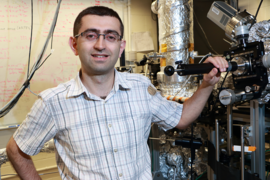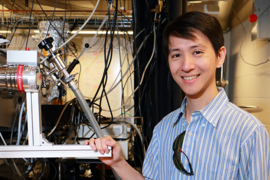Ultrafast laser techniques helped MIT physics graduate student Fahad Mahmood and colleagues establish that electrons form charge-density waves in the thin-film superconductive material LSCO cuprate.
"The question is how does this fluctuating charge-density wave compete or not interfere with superconductivity, and what we found is that it actually competes with superconductivity," Mahmood explains. "Electrons for a very short amount of time are in this charge-density wave state, and in another time scale, if you take another snapshot, they'll be in the superconductivity state."
Charge-density waves occur when electron density in a conductor is distributed in a sinusoidal pattern, like ripples on water, instead of the common uniform density.
"It's a fluctuating order that lasts for a very short amount of time and equilibrium probes won't be able to detect it," he says. Using ultrafast spectroscopy, Mahmood and co-authors of a 2013 Nature Materials paper were able to show that for extremely short periods of time — up to about 2 picoseconds — electrons clustered in a density wave that could be measured by its amplitude and phase.
"This was kind of the very first observation in that particular material that [that] kind of charge-density wave exists, and we were able to make some connections to how it's related to superconductivity as well," says Nuh Gedik, the Lawrence C. (1944) and Sarah W. Biedenharn Career Development Associate Professor of Physics. Gedik spoke about his group's research on topological insulators at the Materials Day Symposium, on Oct.14 in MIT Kresge Auditorium.
Mahmood grew up in Pakistan and won a scholarship to Stanford University, where he studied physics and aeronautical engineering. Now one of Gedik's students, he expects to finish his PhD program next June.
Altering materials with light
An October 2013 paper, led by Mahmood's fellow graduate student, Yihua Wang, demonstrated that intense laser light, below a certain energy threshold, couples with electrons in materials such as topological insulators. This coupling creates a hybrid state known as a Floquet-Bloch state, and it can change the properties of a material by, for example, opening electronic bandgaps. "What we've been able to do is show this hybridization in a real material system," Mahmood says. "These can basically lead to new photo-induced states of matter."
Following up on the light-driven hybrid electronic states, Mahmood has been trying to understand the lifetime dynamics of these states, the length of time these hybrid states persist, and what material properties result from them. Mahmood is now finalizing a paper on the work. "This [work] is going to be important if this ever has some technological significance," Gedik says.
Mahmood studies these topological insulators with angle-resolved photoemission spectroscopy (ARPES), which captures movies of the band structure of the solid. "In every solid, you have a dispersion relation, which maps the energy of the electron with its momentum. If I were to say, 'Inside the solid, there is an electron roaming around, it has this particular momentum. What is its corresponding energy?' With ARPES, we can actually take snapshots of what this relationship looks like. And it turns out that in topological insulators, for the surface, you have a linear dispersion; that means the relationship between the energy and the momentum is a straight line," Mahmood explains.
Graphene, a monolayer form of carbon, also has a linear dispersion, Mahmood adds. "In graphene, and especially in topological insulators," he says, "you'll notice there is no band gap, which means, I can have an electron in every single point in energy. But what we essentially would like to do to make it into a device is to open up a gap in this dispersion, and so there will be regions of energy where there are no states, so electrons won't be able to go to that point, and that acts sort of like an off-on, on-off switch."
"The way to do that in either graphene, or these topological insulators, is the way we proposed," he continues, "we shine light on it, circularly polarized light, and we can actually visually see a gap opening up in this dispersion relationship, using our photoemission methods."
Outside of the lab, Mahmood is the captain of the MIT cricket team, which was the 2014-2015 American College Cricket league home and away championship. "It's a nice activity that keeps me busy and gives me a break from research," he says. After graduate school, he would like to become a postdoc associate and is interested in teaching. His wife, Maggie, whom he met at Stanford, is a high school physics teacher.









